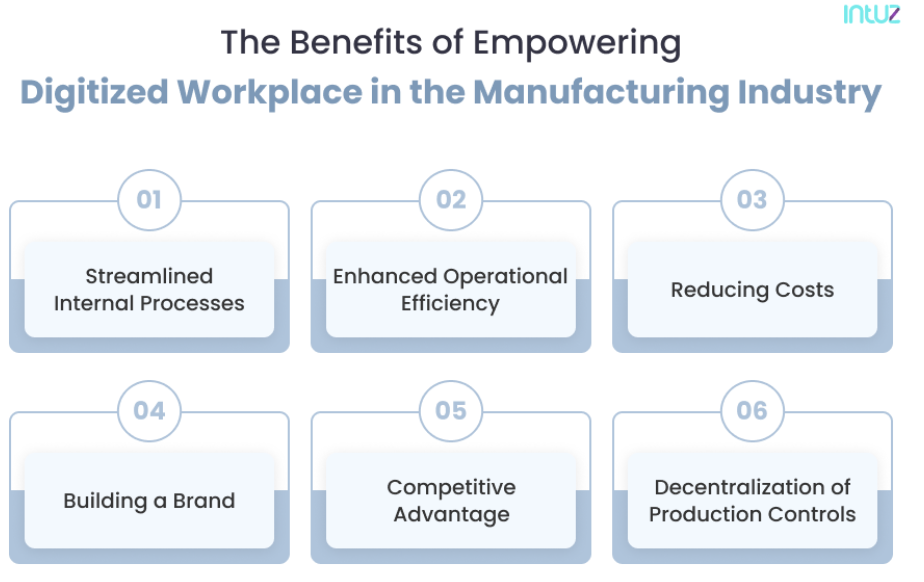How Digitized Workplaces Will Spark Major Industry Change

How Digitized Workplaces Will Spark Major Industry Change
The manufacturing industry is undergoing dynamic transformation due to the COVID-19 pandemic, technology advancements, and the need for more connected processes. Digitized workplaces are opening the doors to optimized manufacturing processes, production efficiencies, enhanced automation, reduction of wastage, and revenue boost.
The far-reaching implications of the global pandemic have affected all major aspects of manufacturing, from procurement to supply chain.
While the supply chain and inventory management aspects are thoroughly debated, the manufacturing industry's internal working, workforce management, and operational processes are sorely underexplored.
Operational and workforce readjustment challenges arising from remote work imposition have called for greater adoption of digital technologies, redesigning manufacturing spaces, and using innovative tools.
A digitized workplace can provide solutions to many of the pressing issues of the manufacturing industry.
Looking to take your workplace to the next level? Connect with the best IT consulting services firms on The Manifest.
What is a Digitized Workplace?
A digitized workplace is a virtual office environment replicating several elements of productivity and collaboration using a combination of digital tools such as IIoT, Cloud Computing, Data Analytics, and more.
Although the manufacturing industry has seen a 65% increase in its digital transformation efforts post-pandemic, it is still far from what is needed to stay relevant in the market. The manufacturing digital transformation was valued at $263 billion in 2020. It is predicted to touch $767 billion by 2026, growing at a CAGR of 19.48% during the forecast period.
To deal with the compulsions of the pandemic, many companies allowed their employees to work fully or partly from home. However, this is not feasible for the manufacturing industry, especially for warehouse workers, machine operators, service technicians, and other skilled employees.
To stay competitive in the current market, and prepare to face future challenges, the manufacturing industry is compelled to invest in advanced digital transformation technologies, software, and processes.
The Impact of Digitization on the Industry
The impact of digitization on the manufacturing industry is comprehensive, and it provides iterative improvements in quality, productivity, reduced downtime, revenue, efficiency, sustainability, and more. The transformation should happen in tune with the changing market needs, customer requirements, and competitors.

Moreover, digitization should be viewed as a strategy led primarily by real-time data. When real-time manufacturing data is gathered and instantaneously analyzed, it is easier to make real-time decisions. Faster and data-backed decisions are useful, not only, in evoking reactive responses but also in pushing for predictive analytics and preventive maintenance.
Technologies that Lead the Future of the Factory: Industry 4.0
The factory of the future will be led through a combined force of digital technologies such as cloud, analytics, the internet of things, and connected processes to bring immediate and long-term benefits for the business and end-user.

To put the digital strategy in place, the manufacturing enterprise should have a data-backed fluid workspace roadmap to achieve non-linear workspaces instead of monolithic units.
The Future of the Factory: Driven by Industrial Internet of Things
A significant technology leading the digitization efforts of the manufacturing industry is the Industrial Internet of Things. IIoT combines sensors and networking capabilities to help manufacturers improve production efficiency using connected assets. It gives manufacturers greater visibility into their assets, performance, maintenance requirements, etc.
For example, when you embed sensors in your manufacturing equipment, it gathers data about the production process. It sends this data to the central hub, where it is analyzed using ML algorithms.
The ML algorithms then detect variations in production, changes in quality, and inefficiencies in machine behavior, such as excessive vibrations, heat, or noise.
Using such information, it is possible to identify areas of inefficiencies, detect machine condition before it becomes problematic, schedule repair or maintenance, and improve inventory management and procurement of spare parts to prevent unscheduled downtime.
Data Analytics: Generating Real-Time Insights for Business Growth
With the help of IIoT, data is analyzed at the same pace as it is being generated.
Manufacturing is faced with data challenges – that is it relies on increasingly distributed data sources that are presented in inconsistent ways. Many organizations can gather the data but fail to transform it into meaningful outcomes.
As the complexity and volume of data are growing thanks to the implementation of IoT sensors consistently, the need for greater visualization, processing, and analysis is becoming apparent. To bring about breakthrough analytics that significantly impacts the business bottom line, manufacturers should embrace technological solutions with greater computing power.
With seamless data analytics, manufacturers do not have to rely on the efficiencies of their workers to identify patterns, predict outcomes and improve efficiency. Data analytics makes it easier to reassign equipment or workforce, detect bottlenecks and speed up execution time.
Streamlining Operations with Automation and Machine Learning
With automation creeping into manufacturing, employees need not perform routine tasks such as maintenance or quality checks at regular intervals. The equipment can perform such tiresome tasks automatically, and the employee can utilize their experience in performing more critical tasks.
Thanks to automation and IIoT, information about the production process and equipment is collected instantly. However, it must be analyzed to derive useful information from the data. For this purpose, organizations are implementing ML technologies.
ML crunches large volumes of data to recognize patterns, identify trends, forecast market demands, schedule maintenance, and build futuristic models.
Predictive Maintenance for Better Perspective into Equipment Health
Predictive maintenance, propelled by digital tools, directly assesses asset health, current status, and performance. For the manufacturing unit to thrive, it needs to ensure the longest stretch of efficiently functioning machinery, equipment, availability of tools, and interruption-free production lines.
With predictive maintenance, you can reduce downtime, unscheduled stops, breakdowns, and costly repairs, while allowing the production team to schedule maintenance based on the production work orders.
AR/VR Eases the Burden on Workers
Latest technologies, such as Augmented Reality and Virtual Reality, provide greater visibility and real-time information on the production process. AR/VR visualization tools reduce the physical burden on workers by helping them track and report defects, hazards, and deviations from normal machine working.
Head-mounted displays and smart glasses are helping improve worker skill sets and efficiency by reducing training time, providing real-time guidance in handling potential hazards, and reducing error rates.
Workers are also able to collaborate with experts using Remote Assistance for troubleshooting. VR and AR also ease prototyping as workers do not have to physically develop models since they can test the efficiencies of new products using AR/VR-guided systems.
Digitized Workplaces Ease Industrial Employees' Workload
The manufacturing industry is rapidly evolving thanks to rapid digitization and the eager adoption of transformative technologies. Suppose the manufacturing industry, as a whole, is not trudging towards digital transformation now.
In that case, it will soon be struggling to keep pace with changing customer needs, an unproductive workforce, outdated machinery, and obsolete processes.
As a business, developing a digitized workplace could be one of the major priorities going toward transformation. Explore the many benefits of digitization with Intuz. Book a free consultation with our IoT experts to develop customized solutions for your business.
